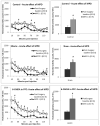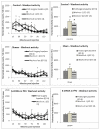Bilateral six-hydroxydopamine administration to PFC prevents the expression of behavioral sensitization to methylphenidate
- PMID: 19932692
- PMCID: PMC4036823
- DOI: 10.1016/j.brainres.2009.11.035
Bilateral six-hydroxydopamine administration to PFC prevents the expression of behavioral sensitization to methylphenidate
Abstract
Psychostimulants like amphetamine and methylphenidate (MPD) are used to treat attention deficit hyperactivity disorder (ADHD), which is marked by developmentally inappropriate inattention, hyperactivity, and impulsivity. Neuropsychological analyses indicate that ADHD patients are impaired on tasks of behavioral inhibition, reward reversal, and working memory, which are functions of the prefrontal cortex (PFC) and are modulated by the mesocortical dopamine (DA) system. Non-specific electrical lesioning of PFC eliminated the expression of behavioral sensitization elicited by chronic MPD administration. Behavioral sensitization is the progressive augmentation of locomotor activity as a result of repetitive (chronic) exposure to the drug. It is believed that the sensitization to chronic drug treatment is caused due to an increase in DA in the mesocorticolimbic DA system, which includes the PFC. Therefore, this study investigated the role of PFC DA in mediating the behavioral sensitization to repeated administration of MPD in adult male Sprague-Dawley rats. On experimental day (ED) 1, the behavior was recorded post-saline injection. On ED 2, the rats were divided into three groups--control, sham and bilateral 6-OHDA treated group; and the sham and 6-OHDA treated groups underwent respective surgeries. After 5 days of rest following surgery, the post-surgery baseline was recorded on ED 8 following a saline injection. All three groups received 2.5 mg/kg MPD for 6 days (from ED 9 to ED 14), followed by a 3-day washout period (ED 15 to ED 18). On ED 19, a rechallenge injection of 2.5 mg/kg MPD was given and locomotor activity was recorded. It was found that the 6-OHDA lesion group failed to exhibit behavioral sensitization to MPD. The involvement of the dopaminergic afferents of PFC in behavioral sensitization to MPD is discussed.
(c) 2009 Elsevier B.V. All rights reserved.
Figures






Similar articles
-
Descending glutamatergic pathways of PFC are involved in acute and chronic action of methylphenidate.Brain Res. 2009 Dec 8;1301:68-79. doi: 10.1016/j.brainres.2009.08.095. Epub 2009 Sep 9. Brain Res. 2009. PMID: 19747456 Free PMC article.
-
Acute and chronic methylphenidate administration in intact and VTA-specific and nonspecific lesioned rats.J Neural Transm (Vienna). 2019 Feb;126(2):173-182. doi: 10.1007/s00702-018-1963-4. Epub 2019 Jan 8. J Neural Transm (Vienna). 2019. PMID: 30617502
-
Glutaminergic signaling in the caudate nucleus is required for behavioral sensitization to methylphenidate.Pharmacol Biochem Behav. 2019 Sep;184:172737. doi: 10.1016/j.pbb.2019.172737. Epub 2019 Jun 19. Pharmacol Biochem Behav. 2019. PMID: 31228508 Free PMC article.
-
The role of age, genotype, sex, and route of acute and chronic administration of methylphenidate: a review of its locomotor effects.Brain Res Bull. 2006 Feb 15;68(6):393-405. doi: 10.1016/j.brainresbull.2005.10.005. Epub 2005 Oct 27. Brain Res Bull. 2006. PMID: 16459193 Review.
-
The cognition-enhancing effects of psychostimulants involve direct action in the prefrontal cortex.Biol Psychiatry. 2015 Jun 1;77(11):940-50. doi: 10.1016/j.biopsych.2014.09.013. Epub 2014 Sep 28. Biol Psychiatry. 2015. PMID: 25499957 Free PMC article. Review.
Cited by
-
Staging perspectives in neurodevelopmental aspects of neuropsychiatry: agents, phases and ages at expression.Neurotox Res. 2010 Nov;18(3-4):287-305. doi: 10.1007/s12640-010-9162-6. Epub 2010 Mar 17. Neurotox Res. 2010. PMID: 20237881 Review.
-
Selective bilateral lesion to caudate nucleus modulates the acute and chronic methylphenidate effects.Pharmacol Biochem Behav. 2012 Apr;101(2):208-16. doi: 10.1016/j.pbb.2012.01.002. Epub 2012 Jan 11. Pharmacol Biochem Behav. 2012. PMID: 22260871 Free PMC article.
-
Improvement of learning and increase in dopamine level in the frontal cortex by methylphenidate in mice lacking dopamine transporter.Curr Mol Med. 2015;15(3):245-52. doi: 10.2174/1566524015666150330144018. Curr Mol Med. 2015. PMID: 25817856 Free PMC article.
-
Acute and chronic dose-response effect of methylphenidate on ventral tegmental area neurons correlated with animal behavior.J Neural Transm (Vienna). 2014;121(3):327-45. doi: 10.1007/s00702-013-1101-2. Epub 2013 Nov 20. J Neural Transm (Vienna). 2014. PMID: 24249696 Free PMC article.
-
Age differences to methylphenidate-NAc neuronal and behavioral recordings from freely behaving animals.J Neural Transm (Vienna). 2022 Aug;129(8):1061-1076. doi: 10.1007/s00702-022-02526-0. Epub 2022 Jul 16. J Neural Transm (Vienna). 2022. PMID: 35842551
References
-
- Adams JU, Careri JM, Efferen TR, Rotrosen J. Conditioned locomotor stimulant effects of cocaine in rats do not result from interference with habituation. Psychopharmacology. 2000;151:13–18. - PubMed
-
- Ahmed SH, Oberling P, DiScala G, Sandner G. Amphetamine-induced conditioned activity does not result from a failure of rats to habituate to novelty. Psychopharmacology. 1996;123:325–332. - PubMed
-
- Algahim MF, Yang PB, Wilcox VT, Burau KD, Swann AC, Dafny N. Prolonged methylphenidate treatment alters the behavioral diurnal activity pattern of adult male Sprague-Dawley rats. Pharmacology, biochemistry, and behavior. 2009;92:93–99. - PubMed
-
- Anderson JC, Williams S, McGee R, Silva PA. DSM-III disorders in preadolescent children: Prevalence in a large sample from the general population. Arch Gen Psychiatry. 1987;44:69–76. - PubMed
-
- Arnsten AF, Steere JC, Hunt RD. The contribution of alpha 2-noradrenergic mechanisms of prefrontal cortical cognitive function. Potential significance for attention-deficit hyperactivity disorder. Arch Gen Psychiatry. 1996;53:448–455. - PubMed
Publication types
MeSH terms
Substances
Grants and funding
LinkOut - more resources
Full Text Sources
Miscellaneous

